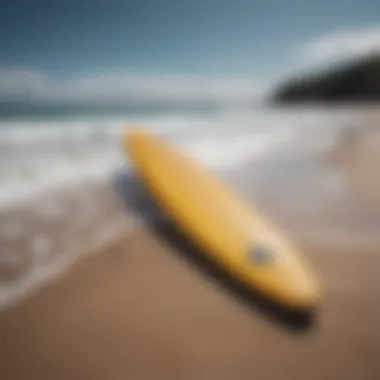The Evolution and Use of Surfboards with Foils


Intro
The world of water sports has always been a dynamic playground for innovation and creativity. Among its recent advancements, surfboards equipped with foils have carved out a unique niche, pushing the boundaries of how surfers interact with waves and harness the water's energy. This evolution merges traditional surfing with cutting-edge hydrofoil technology, resulting in a thrilling riding experience that elevates enthusiasts above the churning sea.
As the sport evolves, it becomes not just about the ride, but also about understanding the mechanics, techniques, and safety measures that come with this new gear. While the allure of gliding above water captures the imagination, diving deeper into the specifics reveals a complex interplay between design, function, and style. The journey through surfboards with foils is not simply a trend; rather, it's a transformation reflecting both technological advances and shifts in surfing culture.
This piece aims to be a practical guide and insightful read for both seasoned surfers and those new to the sport. As we explore the evolving world of foils, we will uncover valuable insights on gear selection, tricks and techniques, and essential safety practices to enhance every rider's experience on the water.
Preface to Foil Surfboards
Surfboards with foils have gained footing in the surfing community, bringing a fresh perspective to this age-old pastime. The introduction of these boards represents a blend of art and science, fundamentally changing the way surfers approach their craft. As we explore what foil surfboards are and their history, it's vital to appreciate their significance in modern water sports. These innovations not just elevate the surfing experience, but they also challenge traditional surfing norms.
Defining the Foil Surfboard
A foil surfboard stands out due to its unique design, which incorporates a hydrofoil underneath the board. This crucial component consists of a wing-like structure that extends below the waterline, allowing the rider to lift above the water surface at high speeds. Essentially, the hydrofoil transforms the interaction of the surfboard with the wave dynamics. The board glides over the water rather than riding on it, which offers a new level of speed and grace.
The concept of lift is pivotal here. When surfers gain enough speed, the foil creates an upward force, enabling them to rise above the water. This changing relationship with the ocean adds a new layer of excitement and skill to the sport. The feeling of soaring above the water can be intoxicating, offering a glimpse of what some might call flying—it's unlike anything traditional surfing can provide.
Historical Context and Development
The journey of foil surfboards is intriguing. Originally, the concept sprouted from windsurfing in the late 20th century. Adventurous spirits, seeking to push boundaries, began experimenting with hydrofoils attached to their boards. In the 1990s, this innovation took a significant leap forward with designs increasingly tailored to enhance performance in surfing.
By the early 2000s, these advancements caught the attention of surf enthusiasts. The modern foil surfboard appeared, sparking discussions on whether this evolution added value or detracted from traditional surfing values. Some bread-and-butter surfers favored the raw experience of waves, yet many embraced the changes and saw them as an exciting evolution.
An important milestone in the foil surfboard evolution was the introduction of commercially available models, allowing a wider audience to experience this novel technology. Companies began to innovate, producing boards with varying dimensions and foil configurations to cater to different skill levels. As riders pushed the limits of foil technology, they uncovered diverse applications, from flatwater lakes to hefty ocean swells.
"The introduction of foil surfboards is not merely about riding the waves; it's about redefining the experience of surfing itself."
From humble beginnings rooted in experimentation to becoming a mainstay in surf shops, the evolution of foil surfboards reflects a captivating journey that has captured the imagination of hobbyists and competitors alike. Their presence is a testament to surfing's adaptability and the unyielding human desire for exploration.
Mechanics of Foil Technology
The world of water sports has evolved rapidly, and within this evolution, foil technology stands out as a game-changer. Foil surfboards merge traditional surfing with cutting-edge technology, elevating riders above the waves. This section explores the mechanics behind foils, shedding light on their operational principles and the materials that define their design. Understanding these elements is crucial for anyone looking to master this innovative sport.
How Foils Operate
At the core of every foil surfboard is the hydrofoil, an underwater wing designed to lift the board out of the water as it moves. This lift is generated through the interaction of water flowing over and under the wing shape. When a surfer paddles into a wave, the hydrofoil engages, allowing the rider to experience a unique sensation of flying over the water. This not only provides a smoother ride but also reduces drag, allowing for higher speeds and more control while navigating swells.
The key to its operation lies in the angle of attack—the angle at which the foil enters the water. A more significant angle increases lift but can also lead to turbulence if pushed too far. Surfers quickly learn to adjust their weight and positioning to maintain an optimal angle, leading to a learning curve that some describe as captivating and challenging.
"Foil surfing isn't just about the ride; it's about mastering the nuances of balance and technique."
Understanding how different water speeds affect lift is another aspect surfers need to grasp. In slower conditions, maintaining the right balance becomes essential to prevent the foil from breaching the water surface. Conversely, with increased speed, there’s a thrilling sense of flying that can be both exhilarating and daunting.
Material Composition and Design
Foil surfboards are not just simple slabs of resin and foam; they are complex machines built with precision and purpose. The materials chosen play a significant role in a foil’s performance and durability.
Common materials include:
- Carbon fiber: Lightweight and incredibly strong, carbon fiber helps create boards that are responsive and agile.
- Fiberglass: While slightly heavier than carbon fiber, it is durable and often more affordable, making it a popular choice for many surfers.
- Aluminum: Used in some foils for its strength-to-weight ratio and resistance to corrosion, this material offers reliability for those who venture into saltwater environments.
Design is equally crucial. The shape and size of the foil can dramatically influence the performance of a surfboard. For instance, a larger surface area can provide more lift but may feel bulkier, while a smaller wing allows for greater maneuverability but requires more speed to stay up. Riders will often experiment with different wing setups to find the perfect balance for their surfing style.
A common design element is the mast, which connects the foil to the surfboard. Masts come in various heights, impacting how deep the foil sits in the water. Longer masts allow for bigger waves, as they keep the foil submerged even in steep drops, but they also can make controlling the board more difficult.


Advantages of Using a Foil Surfboard
Foil surfboards have carved out an impressive niche in the surfboarding world. They’re not just a neat gimmick; they offer real benefits that change the way riders interact with the ocean. Understanding these advantages is crucial for anyone looking to up their game on the waves. Let’s take a closer look at the top three advantages of using a foil surfboard, each designed to enhance one’s surfing experience.
Enhanced Speed and Maneuverability
One of the standout features of foil surfboards is their ability to achieve remarkable speed. When a surfer is on a foil, the board lifts above the surface, drastically reducing drag. It’s like cruising down an open highway compared to climbing a steep hill. As a result, riders can catch waves earlier and maintain momentum longer. This speed allows for quicker turns and sharper angles, making it easier to maneuver around obstacles in the water. Surfers often find that they can perform tricks and maneuvers that would be nearly impossible on standard boards.
Additionally, this enhanced maneuverability opens the door to exploring new lines and routes on familiar waves. Riders who've gotten the hang of foiling tend to have a new strategy when picking waves, considering factors like wind and swell direction in ways that traditional surfing doesn’t demand. It’s not just about going fast; it's about harnessing that speed to ride smarter.
Improved Wave Riding Experience
Foil surfing has a way of elevating the wave riding experience. Riders often report a sense of freedom and excitement that is hard to replicate with regular surfboards. Once up on the foil, surfers glide smoothly across the water, feeling as if they are floating above the surface. This sensation enhances the thrill of catching waves, as the board effortlessly glides over chop and foam. It creates a seamless connection between rider and wave, enabling them to carve turns and ride swells like never before.
Moreover, foil boards enable surfers to engage with a wider range of wave types. They can catch smaller, less powerful waves that might not be rideable on traditional boards. It’s almost like discovering a hidden gem in a familiar place. The freedom to ride smaller swells opens new opportunities and extends the season for many surfers.
Extended Riding Conditions
Weather and water conditions can sometimes be a surfer’s worst enemy. Choppy waters, onshore winds, or lack of swell can deter many from hitting the waves. However, foil surfboards are built to tackle less-than-ideal conditions. They are less affected by choppy water thanks to their design, allowing for smoother rides even under difficult circumstances.
For instance, while a typical surfboard struggles in a windy environment, a foil board can provide stability and control, enabling riders to continue having fun while others sit it out. This adaptability means longer sessions and more days on the water, which is particularly appealing to avid surfers and adventurers looking to maximize their time—no more waiting for "perfect" conditions.
The blend of speed, agility, and adaptability in foil surfboarding isn’t just a fad; it’s a full-on transformation in how we engage with water sports.
In summary, the advantages of using a foil surfboard are not merely superficial but deeply enhance the overall surfing experience. From discovering a new approach to speed and maneuverability to extending the range of rideable conditions, foils are becoming essential tools for those serious about the sport.
Key Considerations When Choosing a Foil Surfboard
Choosing a foil surfboard isn't a walk in the park; it's more like navigating a maze where the walls keep shifting. There's a lot to consider before making a purchase, from the technical specifications to how they can impact your performance in the water. Foil surfing is an exhilarating experience, but to enjoy it fully, one must understand the fundamentals that dictate the suitability of a board.
Here's a deeper look into what factors should guide your decision-making process:
Sizing and Weight Factors
Getting the right size and weight for your foil surfboard is crucial. If you pick a board that’s too long, it could feel unwieldy, perhaps even causing you to struggle keeping your balance. Conversely, a board that’s too short may lack the surface area that provides stability, particularly for those still learning the ropes.
Factors influencing size include:
- Rider Weight – Heavier riders might benefit from longer boards to ensure stability.
- Skill Level – Beginners often find wider boards easier to balance on.
- Conditions – If you plan to ride in smaller waves, a shorter board can be nimble and responsive.
Getting these factors right can make the difference between an enjoyable ride or a frustrating experience.
Selectivity in Design Features
Dive into the specs of different foil surfboards and you'll see a world of diverse design features. It's not all about aesthetics; each aspect affects how the board performs. Consider the following elements:
- Foil Placement – Some boards have adjustable foil tracks, allowing riders to tweak the location of the foil, which can alter the balance and lift.
- Tail Shape – A narrow tail can increase speed, while a wider tail can provide extra lift and improve stability.
- Material – The choice between fiberglass, carbon fiber, or epoxy can influence weight and performance. More advanced materials often come with a higher price tag but can offer enhanced responsiveness and strength.
The right features can elevate your riding experience, tailoring it to your style and preferences.
Cost vs. Performance Analysis
Money talks, especially in the world of foil surfboarding. The reality check is that quality often comes with a price, but you need not break the bank to get a good board. Here's how to assess whether the investment is worth it:
- Set a Budget – Determine how much you're willing to allocate for a board. Set your financial limits wisely because foils can range from a couple of hundred to a couple of thousand dollars.
- Evaluate Performance & Longevity – Lower-priced boards may save you cash upfront but risk sacrificing on performance and durability. On the other hand, high-end models usually come with advanced technology that can enhance your surfing experience significantly.
- Customer Reviews – Don’t underestimate the wisdom of crowds. Websites such as Reddit have communities that discuss boards extensively. Often, you can find solid leads on performance and reliability from fellow surfers.


In short, weigh your options carefully. A well-chosen foil surfboard can provide immense value in the long run, allowing riders to enjoy this unique experience to the fullest.
Riding Techniques and Skills
When it comes to surfing with foils, mastering the riding techniques and skills is paramount. This isn't just about aesthetics; it's the key to an enjoyable and safe experience on the water. In this section, we’ll delve into crucial aspects of riding, highlighting how each element contributes to performance and safety.
Basic Riding Posture
Getting the posture right is like the foundation of a sturdy house; it sets the stage for everything that follows. The basic riding posture on a foil surfboard is fundamentally different from traditional surfing.
Firstly, a rider should position their feet shoulder-width apart, firmly planted on the board. The back foot should be near the tail, while the front foot rests slightly ahead towards the middle. Keep your knees slightly bent and your weight centered. This stance aids in balance, allowing the board to rise above the water effortlessly. Leaning slightly forward helps maintain momentum.
Moreover, the importance of a straight back cannot be overstated. A bent posture can lead to injuries and impair balance.
"Good posture isn’t just about looking good; it’s about feeling good and riding well."
Advanced Maneuvers for Foil Surfing
Once you're comfortable with basic posture, it’s time to step it up. Advanced maneuvers can significantly enhance your surfing experience.
- Carving Turns: Initiate a carve by shifting your weight on your back foot, which turns the board while the foil lifts effortlessly. The key is to maintain speed while changing direction.
- Pumping: This technique allows you to generate speed without relying solely on the wave. By shifting your weight from foot to foot, you create lift and thrust.
- Jumping: Yes, you can catch air with a foil. Approach a wave with speed, compress your legs, and then spring off as you hit the lip of the wave. Timing is crucial here, so practice makes perfect.
Each maneuver offers its own thrill and demands different skill sets. Start slow, practice regularly, and look for feedback either from instructors or fellow surfers.
Adjusting to Different Conditions
Surfing foils means being able to adapt to changing conditions. The ocean is a dynamic environment; factors like wind, waves, and swell size can vary drastically.
- Wind Conditions: Understanding how wind affects your ride is crucial. Light winds are ideal for beginners as they create a smoother surface. Strong winds can lead to choppy water; knowing how to handle these conditions is essential for more experienced riders.
- Types of Waves: Not all waves suit foil riding. Steep, fast-breaking waves provide the best lift, but take time to learn how to navigate them. Look for waves with a gentle slope if you're still honing your surfing skills.
- Equipment Setup: Make sure to adjust your foil position and board length based on the conditions. A longer mast works better in choppy water, while a shorter one is ideal for smooth days.
As you progress in your foil surfing journey, you will naturally start to recognize what works best for varying conditions. Being flexible in your approach can be a game changer.
Safety Considerations While Foil Surfing
Safety should hold a prime spot in the playbook of any foil surfer. As this innovative sport merges the challenges of traditional surfing with new dynamics introduced by hydrofoils, acknowledging the risks involved is crucial. Not only does understanding these risks help in avoiding accidents, but it also ensures an overall enjoyable experience on the water. It's not just about catching waves; it's about doing so with confidence and care.
Understanding the Risks
Riding a foil surfboard presents unique hazards that might not be evident to those accustomed to standard surfing. Here are some risks to keep on the radar:
- Impact Injuries: The foil’s structure juts beneath the water, creating potential for injuries upon falls, such as cuts or bruises from the sharp edges of the foil.
- Balance Issues: Learning to balance on a foiled board can be tricky; miscalculations may lead to unexpected wipeouts, potentially resulting in collisions with the board or foil.
- Environmental Factors: The unpredictability of ocean conditions can swing the odds against you. Waves can shift suddenly, and currents can pull you into areas with rocks or reefs if you’re not vigilant.
"Injuries are like waves; they come when you least expect them, and handling them with care can save your ride."
To navigate these pitfalls, consideration for personal skill level and environmental conditions is crucial. Beginners may wish to practice in calmer waters before tackling heavier swells.
Proper Equipment Usage
Using the right gear correctly can make a world of difference in minimizing risks. Here are some guiding principles:
- Helmet and Impact Vest: Always wear a helmet and a buoyant impact vest. These aren’t just accessories; they are essential for shielding against impact and enhancing visibility.
- Quality Foil and Board: Invest in well-reviewed brands like Naish or Slingshot, which have a reputation for safety and performance. A solid, well-maintained board increases stability.
- Pre-Ride Checks: Before heading out, do a gear inspection. Ensure the foil maintains a tight attachment to the board and that the leash is secure to avoid losing your equipment in a fall.
By prioritizing safety and understanding risks, not only does surfing become more enjoyable but also less stressful for those involved. Half the fun of foil surfing is about pushing boundaries, but doing so with safety in mind is key. With preparation and awareness, this thrilling sport can be fully embraced by surfers of all levels.
Impact on Surfing Culture


The introduction of surfboards with foils has not only transformed the physical experience of riding waves but has also had a profound impact on the culture surrounding surfing. As surfers integrate this advanced technology into their routines, it inevitably changes how the sport is perceived and practiced. By understanding these cultural shifts, we can better appreciate both the tradition of surfing and its innovative future.
Changing Perceptions of Surfing Techniques
Foil surfing has led to a notable evolution in the techniques employed by surfers. Unlike traditional surfing, where the emphasis is on riding waves at their peaks, foiling allows surfers to glide above the water. This shift in technique requires a different set of skills, including balance, timing, and an understanding of hydrodynamics. Additionally, the adrenaline rush of being elevated above the surface offers a unique thrill that many surfers find irresistible.
As surfers adopt this new approach, perceptions of what constitutes good surfing are also changing. The ability to engage with smaller waves previously deemed unrideable is now an attractive aspect of foiling. Some purists might critique this shift, arguing that foil surfing is a departure from traditional practices.
However, it can’t be ignored that it opens the sport to newcomers, encouraging them to tap into their creativity and explore wave riding in innovative ways. In essence, foil surfing is providing a fresh layer to an old craft, creating new conversations around technique and style.
Emergence of New Surfing Communities
The rise of foil surfing has fostered the development of new communities within the broader surfing culture. These communities tend to be more communal and often emphasize collaboration over competition. Unlike traditional surf groups that can be highly territorial, foil surfers often share tips and tricks freely. This newfound camaraderie has resulted in social media groups and local meetups focused solely on sharing experiences related to foiling.
Moreover, as more surfers transition to foil boards, we're seeing increased diversity in surf spots and local scenes. Beaches that once were exclusive domains of advanced surfers are now filled with people trying their hand at foiling, thus changing the demographic and social landscape of these locations.
With each wave, foiling is not just a sport; it’s a community forging new paths and breaking old barriers.
This communal aspect makes foil surfing more accessible and inviting. It diffuses the elitism that sometimes runs rampant in traditional surfing circles. Consequently, this increased inclusivity doesn’t just impact interactions among surfers; it also influences the way local businesses engage with the surf culture, resulting in a broader market of services and products catering to foil enthusiasts.
In summary, as surfboards evolve with technology, they are reshaping the cultures around them. The changing techniques and the blossoming of new communities are key indicators of how foiling is impacting the perception of surfing as a whole. This cultural evolution promises to enrich the sport, making it more adaptable and inclusive for years to come.
Future Trends in Foil Surfing
As the world of surfing continues to evolve, so does the technology that enhances it. Foil surfing is no exception, as it represents a growing intersection between tradition and innovation. The importance of understanding future trends in this area cannot be overstated. With environmental concerns, technological advancements, and shifts in competitive structures, foil surfing stands on the brink of potentially groundbreaking changes that promise to reshape the sport.
Technological Advancements
The coming years are likely to see technological advancements that will transform the way foil surfboards are designed and constructed. Expect to find lighter materials that enhance buoyancy and maneuverability, paired with more aerodynamic shapes. Foam and composite blends will dominate, armed with cutting-edge manufacturing techniques that reduce waste while emphasizing performance.
- Nanotechnology could revolutionize epoxy coatings, making surfboards more durable and resistant to scratches.
- Smart technology might also be integrated into surfboards. Imagine having sensors and apps that track performance metrics or provide real-time feedback on your riding technique!
Additionally, innovations in hydrofoil design will likely lead to increased stability and safety when navigating various coastal conditions. Riders have long wrestled with balance and control; advancements may mean that even novice foilers can glide effectively atop the water.
"Embracing the changes in technology not only pushes the boundaries of surfing but also brings an entirely new audience into the fold."
Potential for Competitive Foil Surfing
Foil surfing could take a leap into competitive frameworks as the sport gains traction. With established competitions and the potential for new events, the dynamics of water sport tournaments may shift significantly. The International Surfing Association has already begun to explore how foil surfing might fit into their competitive structure, potentially formalizing categories that distinguish between traditional surfing and foil surfing.
- Emergence of New Competitions: Look out for dedicated foil events, driven by increasing interest from both spectators and athletes. This could introduce exciting new formats and styles of competition.
- Regional Championships: Local communities might start hosting foil competitions, further diversifying the surf culture and fostering novice talent.
As competitive foil surfing gathers momentum, there's also a potential for collaboration between brands and professional riders. Sponsorship deals could focus more on individual performance and the promotion of foil technologies, creating new pathways for athletes looking to make their mark in the scene.
In summary, the future trends in foil surfing promise transformations that touch on technology, competition, and community engagement. These trends are not just about refinement in equipment but also about reimagining what it means to ride the waves. With ongoing advancements and the rise of competitive events, foil surfing is likely to attract a broad spectrum of kiteboarders, instructors, and enthusiasts, leaning into the richness of both community and individual expression.
End
In wrapping up our exploration of surfboards equipped with foils, it’s crucial to emphasize their significance in the surfing landscape. The rise of foiled surfboards has transcended mere innovation; they represent the intersection of tradition and modernity in water sports. With advances in hydrofoil technology, surfers can achieve new levels of performance and adaptability that were previously unattainable.
Recapitulating Key Insights
From the mechanics of how foils function to the specific riding techniques that can be adopted, several key points emerge. First, the design of foiled surfboards showcases a blend of lightweight materials & aerodynamics, enhancing both speed and stability. Surfers, whether novices or experienced riders, must understand how to choose the right gear based on their personal weight, skill level, and the typical wave conditions they encounter.
Moreover, the benefits of foiled surfing include not only the thrill of soaring above the surface but also the ability to ride a wider variety of waves. This greatly expands opportunities for practice and enjoyment. As our discussion highlighted, adjusting techniques for different setups can make all the difference in performance.
Final Thoughts on the Evolution of Surfboarding
As we consider the future of foil surfing, it’s likely to inspire new trends within the broader surfing community. The emergence of new surfing communities, driven in part by the excitement around foils, illustrates a shift in how water enthusiasts engage with the sport. Competitions will likely evolve, while local groups share tips and experiences, enhancing the communal aspect of surfing.
"Innovation in sports often leads to a deeper understanding of the challenges and joys involved, pushing the limits of what we once thought possible."
The continued evolution of surfboards with foils marks a pivotal moment that combines equipment advancements with changing cultural dynamics in the aquatic realm. This progress invites all surfers to reconsider their approach to the waves and the ways in which they engage with the water.















